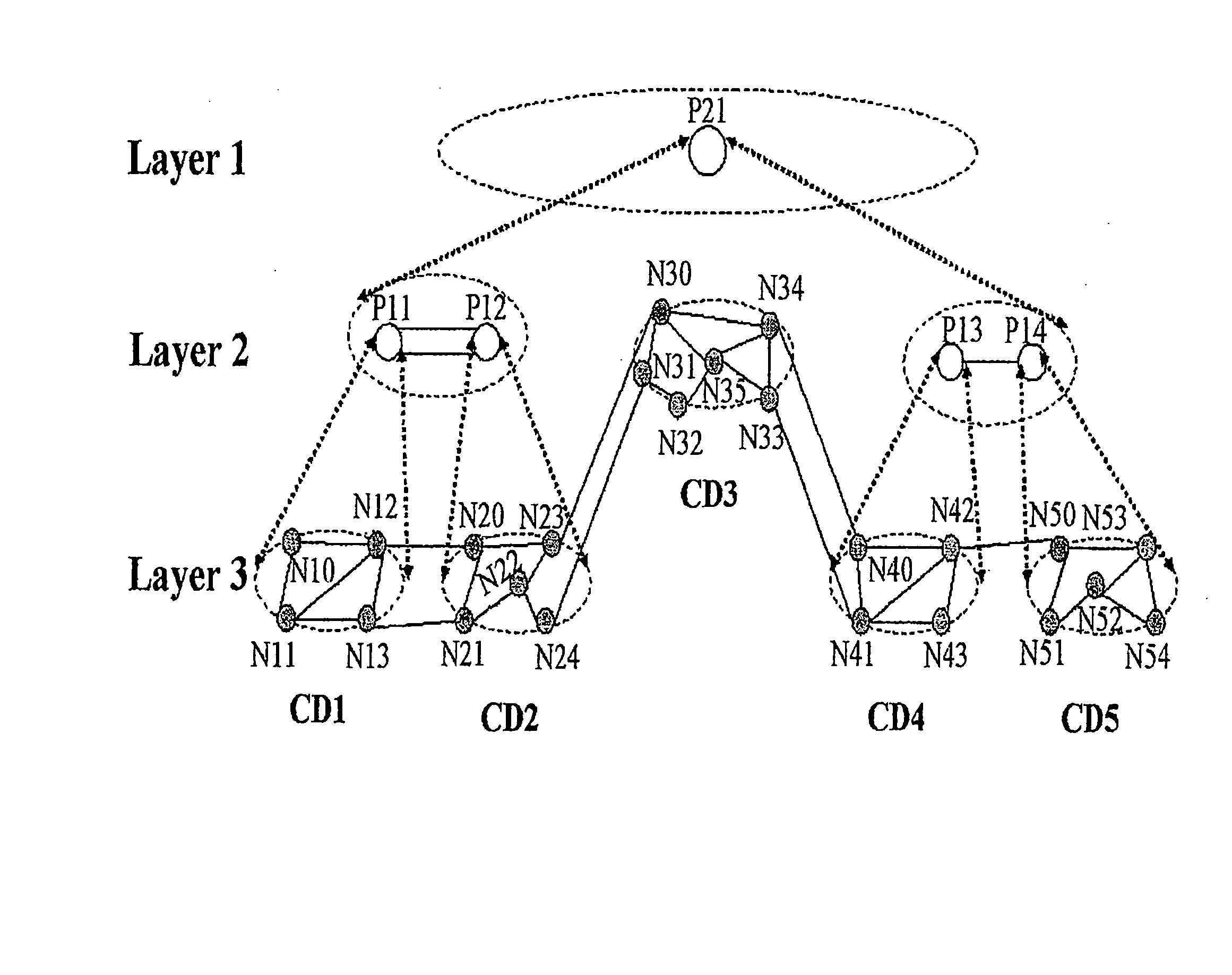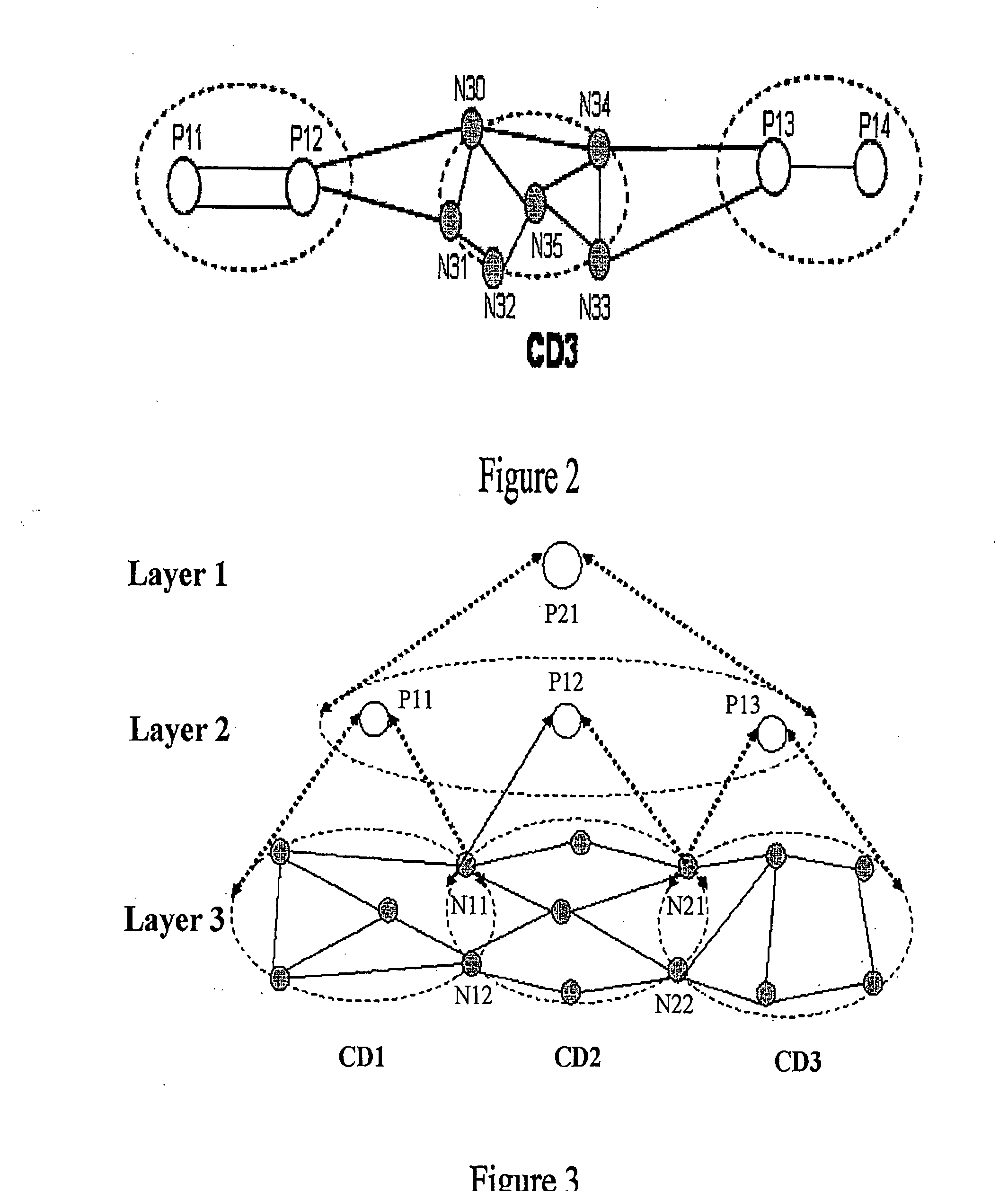Method and system for multi-domain route computation
a multi-domain route and computation technology, applied in the field of communication technologies, can solve the problems of difficult to compute end-to-end diverse routes, difficult to manage and maintain route computation, serial process of route computation, etc., to avoid rollback risk, increase the efficiency of route computation, and reduce the volume of communication between pces
- Summary
- Abstract
- Description
- Claims
- Application Information
AI Technical Summary
Benefits of technology
Problems solved by technology
Method used
Image
Examples
first embodiment
[0041] In the method, when a user sends a command to establish a service connection between N10 and N13, route computation is carried out in the following procedure:
[0042] Step A: Determine a PCE whose computation domain may include both N10 and N13. Because when the source node N10 requests P11 whose computation domain includes N10, to do route computation, P11 may determine that the destination node N13 is also included in its computation domain. Therefore, it can be determined that P11 is the PCE whose commutation domain includes both N10 and N13. This means, P11 is the top layer PCE for this route computation.
[0043] Step B: P11 and its lower layer PCEs complete the route computation together. Because P11 has no immediate lower layer PCE, it does the route computation directly. The computation result is, for instance, N10→N11→N13.
second embodiment
[0044] In the method, when a user sends a command to establish a service connection between N10 and N53, route computation is carried out in the following procedure:
[0045] Step A: Determine a PCE whose computation domain may include both N10 and N53. This step further includes:
[0046] Step A1: The source node N10 sends a request for route computation to P11 whose computation domain includes N10.
[0047] Step A2: P11 finds that N53 is not included in its computation domain, or the computation domain of P11 does not include N10 and N53 at the same time. Then P11 forwards the request for route computation to its immediate upper layer PCE, P21.
[0048] Step A3: P21 finds that N10 is included in the computation domain of P11, one of its immediate lower layer PCEs, and that N53 is included in the computation domain of P14, another of its immediate lower layer PCEs. This means the computation domain of P21 may include both N10 and N53. Therefore, P21 determines that it is the PCE whose compu...
third embodiment
[0058] In the method, when a user sends a command to establish a service connection between N10 and N53, route computation is carried out in the following procedure:
[0059] Step A: Determine a PCE whose computation domain may include both N10 and N53.
[0060] This step Her includes:
[0061] Step A1: Source node N10 sends a request for route computation to P11, whose computation domain includes N10; N10 (or P11) notifies destination node N53 to do route computation and N53 sends a request for route computation to P14, whose computation domain includes N53.
[0062] Step A2: P11 detects N53 is not included in its computation domain, which means the computation domain of P11 does not include N10 and N53 simultaneously. Therefore, P11 forwards the request for route computation to P21, which is its immediate upper layer PCE and sends its computation result N10→N12 to P21 for reference. P14 detects that N10 is not included in its computation domain, which means the computation domain of P14 do...
PUM
 Login to View More
Login to View More Abstract
Description
Claims
Application Information
 Login to View More
Login to View More - R&D
- Intellectual Property
- Life Sciences
- Materials
- Tech Scout
- Unparalleled Data Quality
- Higher Quality Content
- 60% Fewer Hallucinations
Browse by: Latest US Patents, China's latest patents, Technical Efficacy Thesaurus, Application Domain, Technology Topic, Popular Technical Reports.
© 2025 PatSnap. All rights reserved.Legal|Privacy policy|Modern Slavery Act Transparency Statement|Sitemap|About US| Contact US: help@patsnap.com



